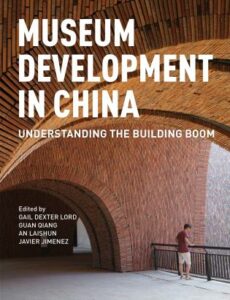Museum Development in China: Understanding the Building Boom, edited by Gail Lord, Guan Qiang, An Laishun & Javier Jimenez. Lanham: Rowman & Littlefield, 2019.
REVIEWED BY CAMILLE COMBAUD

This book, compiled by three museum planners with plenty of experience, aims to explore the recent changes in museum development in the country of China: through four parts, the authors explore the organization and construction of Chinese museums through history and today. Each chapter is written by different authors, offering a variety of essays around specific themes such as the place of museums in urban development, their role in cultural diplomacy or the expectations of the public, to name a few. Pictures are used to illustrate the arguments and bring life to the narratives.
The first part focuses on the history of the museum in China: the chapters are arranged in a way that brings us to the present day, concluding on the “social role of museums” in current Chinese society. Though most of this part is focused on the 20th and 21st centuries, the introduction starts with a fact that may surprise Western audiences: according to scholars, museums exist in China since 478 BCE. This sets the tone for the rest of the part: using statistics, for examples the fact that China has opened more museums in the last 15 years than all other countries combined, and examples (i.e., how the Thirteenth Five-Year Plan encouraged the development of museums), the book does a great job at explaining the ever-growing importance of the concepts of preservation and educating the public about history.
The second part explores the place of museums in the urbanization of China. The country’s recent economic boom has allowed for a rapidly expanding urban landscape, in which the museums must find their place. The museum is not only about its content, but also exists through its architecture: how do we reconcile modern techniques, cultural traditions and site limitations? Through pictures of museums such as the Tianjin Museum or the expansion project of Memorial Hall of the Victims of the Nanjing Massacre, the book invites the reader to realize that although some constraints are similar to the ones encountered in Western countries, others are different. This may be due to cultural or historical differences or specific locations that bring new challenges to the drawing table.
The third part deals with the aspect of internationalization and cultural diplomacy: aspects such as soft power or cross-cultural collaborations are addressed through specific chapters. Once museums have been suited to the local and national public, how do Chinese experts reach out to a foreign public? These issues are addressed, as well as the outside influences that left their mark on museum history in China, i.e., Soviet influence during the Cold War.
The fourth and last part gathers case studies on innovation, offering insight on what could be the future of museum development in China. It is possible to see topics that are influential and debated in the international museum studies community, such as the “public demands for new experiences” or the “smart museum” which throws new technologies into the mix, while others are more specific to China as a framework, such as the re-thinking of institutional organizations. Using an array of specific case studies, authors can show concretely how the situation is evolving as of today.
This book offers a compilation of viewpoints on a museum culture that is not often studied by Western audiences: most of the authors are accomplished museum professionals and often of Chinese citizenship themselves, allowing the reader to get an insider explanation on the recent museum boom in China. The inclusion of pictures and the rather short essays make this a rather easy and pleasant read, and yet the organization in four parts and successive chapters allows for continuity and logic in the way arguments are presented. The short aspect of these essays may be one of the only weaknesses, as each of those chapters explore issues that could potentially fill entire books – but the goal here is to offer a complete and varied history and exploration of museum development in China, which it does without a doubt. Museum studies students and professionals will be able to get a good grip on said recent museum development and to compare examples with their own experiences.
Camille Combaud is an exchange MA student in the Euroculture Program at IUPUI, with an interest in museum development and public history.

